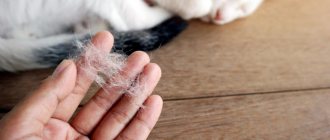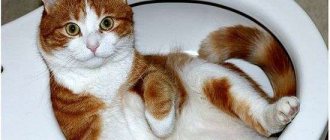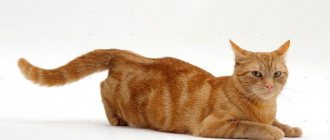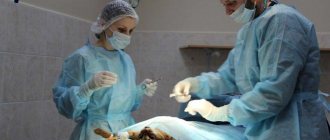We recommend this article as mandatory reading. Knowing the symptoms of a stroke allows you to immediately consult a doctor and provide first aid to your animal. Whether your pet will fully recover depends on your actions.
Animals suffer from the same diseases as people. Stroke also affects cats. Often the consequences are severe or fatal, largely due to owners’ ignorance of the symptoms and too late referral to specialists. You will learn about the signs of a stroke, first aid, treatment and prognosis from the article.
Reference
A stroke is a condition in which the blood supply to the brain is disrupted, causing brain cells to die. As a result, numerous body functions are disrupted, including respiratory, visual, etc.
A stroke occurs in one of two forms:
- hemorrhagic: when a blood vessel bursts in the brain, hemorrhage occurs;
- ischemic: the vessel becomes clogged and becomes an obstacle to adequate blood supply to neurons.
Cats are also prone to micro-stroke. The symptoms are exactly the same as in humans and disappear within a few days. The cat feels a severe headache, partial numbness in the face and paws, becomes too sensitive to light and noise, and coordination of movements is slightly impaired. A microstroke is essentially the same as a stroke, but only affects small vessels, so its consequences are not critical, and the recovery period is relatively quick.
A stroke can be widespread (many areas of the brain are affected) or local (neurons die in only one area). With a major stroke, such a global part of the brain can be affected that the animal quickly dies.
The well-being, severity of the condition, and the speed of rehabilitation of your pet directly depend on which part of the brain is damaged and how badly.
Neutered cats are at particular risk most are overweight and inactive. That is why you need to feed them only with special food and strictly observe the daily caloric intake.
Sometimes a stroke occurs due to anesthesia. As you know, cats have a hard time with it, so they are given local anesthesia.
Preventive measures
Prevention of strokes and micro-strokes in cats are measures aimed at creating quality living conditions. After all, if the owner takes care of his pet properly, the animal is unlikely to get sick. Here are a number of rules that must be followed to prevent your cat from getting sick:
- Provide the cat with the opportunity to take walks in the fresh air (at least on the balcony).
- Normalize the animal's diet (less fat - more vitamins). Diet is especially important for neutered cats. If you don’t know how to properly structure your pet’s diet, you can contact your veterinarian for advice.
- It is imperative to carry out worm prevention (anthelmintics are sold at any pet pharmacy).
- You need to systematically play with your cat (active games are very beneficial for the physical condition of animals).
- Avoid stressful situations for the cat (it is better to make all changes in the house taking into account the pet’s character).
- If your cat is no longer young, then monitor her blood pressure and take your pet to the veterinarian more often.
- Various dangerous and toxic substances must be stored out of reach of the animal (eliminate the risk of poisoning).
And, of course, you just need to take care of your four-legged friend. Cats are smart and unusual, they can love their person and be grateful for care. But unfortunately, animals cannot tell in words about their poor health, so the owner must learn to determine their condition by behavior.
Stroke is a disease caused by a cerebrovascular accident. Strokes are classified by the extent of the damage and the cause of the damage. You cannot self-medicate; illiterate actions by the owner can harm the animal. Only a veterinarian can prescribe medications to treat an injured cat after diagnosis. Following all his recommendations increases the chances of your pet’s recovery.
source
Causes of stroke
Hemorrhagic stroke in cats (with hemorrhage) occurs due to the following factors:
- traumatic brain injury of varying severity.
- vascular inflammation.
- a brain tumor.
- ingestion of poison or toxins into the blood.
- poisoning with severe vomiting.
- prolonged high body temperature due to an infectious disease.
- severe stress.
- excess weight and associated vascular fragility.
- high blood pressure.
- microstroke.
Causes of ischemic stroke:
- cardiovascular diseases.
- impaired kidney function.
- movement of worm larvae through the blood.
- thyroid diseases.
- inappropriate use of hormonal drugs.
- blood clots
- diabetes.
It happens that the veterinarian cannot determine the cause of the stroke. In this case, it will recur with a 99.9% probability - since the provoking factor has not been eliminated. Cats cannot withstand a repeated attack.
Diagnostics
If you suspect that your pet is developing a stroke, you must immediately take the animal to a veterinary clinic.
Attention! It is prohibited to provide any first aid on your own. Firstly, without examination it is impossible to determine that an animal is developing ischemic encephalopathy. Secondly, the principles of veterinary medicine differ significantly from human medicine, so there is a risk of aggravating the pet’s condition.
It is imperative to prepare a complete medical history of the cat and submit it to the veterinarian. Such information will not only help diagnose a stroke, but also speed up the appointment of the correct treatment. If problems with blood circulation appear as a result of injury, the veterinarian will additionally examine other internal organs and do everything possible to stabilize the animal’s condition.
Read also: Coming out of a coma after a stroke
As soon as first aid is provided, the specialist will prescribe:
- complete blood test of the pet (including biochemical profile);
- urine test (to identify possible kidney or liver problems);
- thyroid hormone test (to determine whether a stroke has developed as a result of hormonal imbalances).
In the most modern veterinary clinics, a CT or MRI is required to assess the extent of damage to brain tissue and exclude (or confirm) the presence of blood clots in the blood vessels.
Symptoms of Stroke in Cats
You will notice signs of a sharp deterioration in your cat’s well-being immediately.
- The cat's head will be tilted in one direction. This occurs due to the death of brain cells and the resulting weakness of the neck muscles. This pathology can persist for almost a month.
- Impaired coordination of movements. The pet will stagger, skid like a drunk, and may move unnaturally in a circle.
- General muscle weakness, apathy.
- Memory loss. It manifests itself as a strange reaction to household members: the cat may be afraid of you, hide, rush, or sniff you in confusion, as if getting to know you. He may forget the smell and appearance of the house in which he lives, in which case he will behave as if you first brought him into the room.
- Blindness. The cat will bump into furniture and have difficulty finding bowls. Over the course of several days, compensation occurs - other senses become more acute, so the owner may not understand that the pet cannot see. Vision is partially restored over time in most cases. There is an inhibited perception of the picture.
- The pupil sizes will be different.
- Uncontrollability of bowel and bladder emptying processes.
- Sharp twitching (tic) of the eye from side to side.
- Epilepsy or single seizures.
- Paralysis of one side of the body. The cat will lie motionless. If she is conscious but immobilized, it means that part of the body is paralyzed.
- Lack of appetite, vomiting.
- Brief loss of consciousness.
Acute cerebrovascular accident: development of pathology
To understand what stroke in medicine is, it is important to determine how the brain is supplied with blood and which failures of the circulatory system are the most dangerous. The cervical arteries supply oxygenated and nutrient-rich blood through the foramen magnum into the cranial cavity. The entire organ is densely intertwined with a network of arteries and veins with capillaries extending from them, which allows the neurons to be fully supplied with blood. Each branch of the artery has its own area of responsibility, and through the veins the blood flows from the head, gradually collecting into large vessels.
Both interruptions in the flow of blood through the arteries and failure of the outflow of blood through the veins (so-called stagnation) are dangerous. Typically, acute cerebral circulatory failure occurs in cases where the arteries are damaged and rupture with bleeding or blockage with severe spasm and ischemia of a certain area. Venous problems are more typical for the chronic course of pathological processes due to stagnation of blood in the arteries and veins and a slowdown in the outflow rate.
First aid
As soon as you notice at least 3-4 signs of a stroke, call the veterinarian or take your pet to the clinic yourself.
Before the doctor arrives or during independent transportation, you need to lay the cat on its side on a flat surface. Make sure there is no vomit in the mouth and the tongue does not stick into the throat. Calm your pet, talk to him - your voice will not let him worry. That's ALL you need to do! Do not put a cool compress on your head - this is dangerous for hematoma, do not give medicine.
The sooner you contact a veterinarian, the easier the cat will survive the stroke and recover faster.
Treatment of stroke in cats
Therapy is aimed at eliminating symptoms and supporting the body. It is important to identify what exactly caused the stroke and treat it to avoid a recurrence of the condition. Treatment for stroke in cats lasts at least two months, the recovery period is on average 6 months.
The course of treatment is aimed at relieving pain and relieving spasms, strengthening the walls of blood vessels, normalizing blood circulation and thinning the blood, supporting the heart, restoring the nervous system, removing excess fluid to prevent brain swelling, and generally strengthening the body.
Drugs prescribed for stroke
IMPORTANT! Do not self-treat your cat without consulting a veterinarian.
- Cordiamin. Prescribed for administration in the first three days. The drug affects the central nervous system, stimulates the vasomotor and respiratory centers. For cats, the recommended dosage is 0.1-0.12 ml per kilogram of weight. The injection is subcutaneous, but it can also be injected into the muscle. Sulfocamphocaine has a similar effect, but unlike the first drug, it also has an effect on the myocardium. They inject into the muscle twice a day.
- Eufillin. Improves the function of the respiratory muscles, helps enrich the blood with oxygen and reduce carbon dioxide levels. Subcutaneous administration at a dosage of 0.1-0.2 ml per kilogram of weight.
- No-shpa - tablets or injections. Once a day. Relieves spasms.
- Gamavit is a multivitamin complex.
- Thiotriazolin. Helps normalize lipid, protein and carbohydrate metabolism. Affects the liver and gallbladder, restores hepatocytes and activates the antioxidant system. If the cat weighs less than three kilograms, then a dosage of 1/4 of the tablet or 0.5 ml intramuscularly is adequate. If the weight is over 3 kg, then half a tablet or 1 ml/kg is prescribed. Reception - twice a day.
- Neuromidin (1.5%). The action is aimed at improving memory, accelerating the conduction of impulses along nerve fibers and increasing the contractility of smooth muscle organs. For cats weighing up to 5 kg, the dosage is 0.2 ml. Injects once into the muscle.
- Piracetam. Improves blood supply to the brain. Single injection, 0.5-1 ml.
- Furosemide. Anti-edema. 0.5-1 ml/kg intramuscularly or subcutaneously is sufficient.
- Glucose (5%). Helps supply the body with the energy necessary for the functioning of organs, enhances metabolic processes and dilates blood vessels, promotes the outflow of fluid and enhances the liver’s ability to cleanse the blood of toxins. 15-20 ml once a day is enough.
- Cerucal. Anti-vomiting. Dosage per 10 kg of animal weight - 0.3-0.7 ml. Administration is allowed up to three times during the day.
All treatment and dosage must be prescribed by the doctor individually, based on the results of the tests performed. Therapy should be carried out immediately and also aimed at eliminating the cause. If after three days of treatment no dynamics are observed, the prognosis is disappointing.
The cat may be in the hospital for three to five days. This will allow you to adjust the treatment if necessary.
Cat rehabilitation
The doctor will be able to determine how recovery will proceed after a three-day course of treatment.
When the pet is at home, you will be required to care for it and help. First of all, place it in a warm, clean, comfortable place without drafts. If the cat cannot roll over on its own, you need to turn it over yourself periodically. You may lose control of your bowel movements - you will need to purchase disposable diapers. If there is loss of sensitivity or paralysis of the limbs, massage will be needed. You must not allow your pet to become hypothermic to prevent infection, pneumonia and other diseases from developing.
You may need to syringe feed him.
Cats quickly develop replacement functions: if vision is partially lost, hearing and smell become stronger, and the cat will be able to quickly navigate in space thanks to them.
Usually, after a stroke, if the dynamics are positive, the cat lives as long as normal cats live.
Some functions may not be restored 100%, depending on the severity of the stroke. In some cases, lifelong medication support is necessary.
All that is required of you is patience, support for your pet: love and care will help you recover faster, and unquestioning conscientious fulfillment of the veterinarian’s requirements. We are responsible for those we have tamed. When symptoms are quickly identified and treatment is started on time, then improvement occurs faster.
How to deal with the consequences?
After such a serious illness, the cat goes through a long period of rehabilitation, which can last from six to twelve months.
The cat may experience uncertainty in movements, deterioration or loss of vision and hearing, and often memory loss.
During the rehabilitation period, it is important to give medications prescribed by a veterinarian that will support the animal’s body and help it overcome the consequences of the disease.
All this time, the owner will have to massage the cat himself or with the assistance of a massage therapist who specializes in cats.
The most favorable conditions for the complete rehabilitation of a cat after a stroke are created if the cat began to take treatment on time, and in the very first days its condition began to improve significantly.
Preventing stroke in cats
- The cat needs to breathe fresh air. If she doesn’t go outside, let her breathe on the balcony or window.
- Keep your diet balanced.
- Avoid obesity in neutered cats.
- Never feed your cat stale food.
- Prevent murka's access to house plants - many are poisonous to them.
- Remove potentially toxic substances away (household chemicals, insect poison).
- Protect your little animal from stress.
- Give vitamins and anthelmintics regularly.
- Have active games every day.
Preventive measures
Prevention of strokes and micro-strokes in cats are measures aimed at creating quality living conditions. After all, if the owner takes care of his pet properly, the animal is unlikely to get sick. Here are a number of rules that must be followed to prevent your cat from getting sick:
- Provide the cat with the opportunity to take walks in the fresh air (at least on the balcony).
- Normalize the animal's diet (less fat - more vitamins). Diet is especially important for neutered cats. If you don’t know how to properly structure your pet’s diet, you can contact your veterinarian for advice.
- It is imperative to carry out worm prevention (anthelmintics are sold at any pet pharmacy).
- You need to systematically play with your cat (active games are very beneficial for the physical condition of animals).
- Avoid stressful situations for the cat (it is better to make all changes in the house taking into account the pet’s character).
- If your cat is no longer young, then monitor her blood pressure and take your pet to the veterinarian more often.
- Various dangerous and toxic substances must be stored out of reach of the animal (eliminate the risk of poisoning).
And, of course, you just need to take care of your four-legged friend. Cats are smart and unusual, they can love their person and be grateful for care. But unfortunately, animals cannot tell in words about their poor health, so the owner must learn to determine their condition by behavior.
Stroke is a disease caused by a cerebrovascular accident. Strokes are classified by the extent of the damage and the cause of the damage. You cannot self-medicate; illiterate actions by the owner can harm the animal. Only a veterinarian can prescribe medications to treat an injured cat after diagnosis. Following all his recommendations increases the chances of your pet’s recovery.
source











